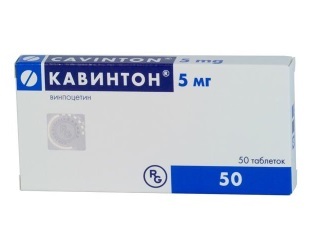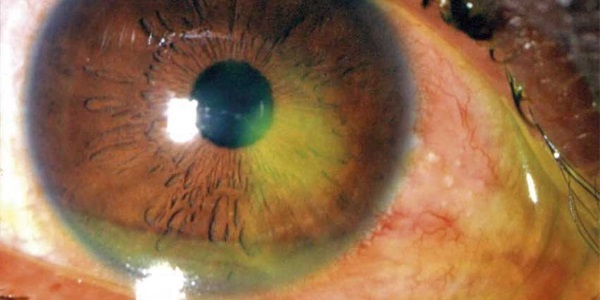
In recent decades, the number of people suffering from vascular pathologies of the eyes has grown steadily.
At the moment, vascular disorders occupy the first place among all causes that cause a significant decrease in vision.
Earlier this group of diseases affected only the elderly, but now more and more young and mature people are losing their ability to work due to vascular disorders.
This is associated with an increase in the incidence of arterial hypertension and metabolic atherosclerosis, which lead to a persistent change in the fundus.
The problem of treatment of vascular diseases remains very relevant, since there are no specific methods that can radically restore the normal functioning of blood vessels.
In such cases, drugs that reduce the density of blood and promote the nutrition of blood vessels and tissues come to the rescue. One such means is Cavinton.
- 1. Instructions for use
- 2. Side effects of
- 3. Storage conditions and expiration date
- 4. Price
- 5. Analogues
- 6. Reviews
- 7. Conclusion
- 8. Video
Instruction for use
Indications for use
The drug is widely used in ophthalmology in the following cases:
- age-related changes in the vascular system of the eye;
- atherosclerotic changes both at normal arterial pressure, and at raised;
- retinal vein thrombosis;
- acute disturbance of the ocular circulation;
- change in intraocular pressure;
- embolism of the vessels of the eye;
- occlusion of the vessels of the eye.
It is also common in neurological practice. The agent is prescribed for:
- stroke;
- ischemic attacks;
- atherosclerotic changes in the brain;
- senile dementia;
- suffered head and brain injuries.
Possible appointment of funds for ENT diseases:
- hearing loss,
- ringing in the ears.
Method of administration and dosage

The drug is administered orally. It is advisable to drink Cavinton after a meal, as this contributes to better digestibility. Usually pills are taken 3 times a day.
The average therapeutic dose of the drug is 30 mg, that is 6 tablets. The clinical effect is noticeable only 7 days after the start of treatment. Usually the duration of treatment is about 21 days.
Parenteral administration of the drug is also possible. In this case, the average therapeutic dose is 50 mg per day. The drug should be administered as slowly as possible( speed not more than 60 drops per minute).
Treatment with Cavinton usually starts with 10 mg, gradually increasing the dosage to therapeutic for 3-5 days.
Form and Composition
The preparation contains vinpocetine. It is a vascular agent that increases the intake of glucose and oxygen by tissues. It has a vasodilating effect and prevents platelets from clumping, diluting blood.
The maximum concentration in the plasma is reached after 60 minutes after the first application. The substance is completely excreted by the kidneys 24 hours after the last application.
Cavinton is available in two forms:
| 1 | Round tablets are white in color, without significant odor. One tablet contains 5 mg of active substance, as well as additional components( lactose, starch, magnesium stearate, colloidal dioxide). Tablets are packed with 25 blisters each. One cardboard package contains 2 blisters |
| 2 | Solution for infusions of green color.1 ml of the solution contains 5 mg of active ingredient and various auxiliary components( water, benzyl alcohol, sodium sulfite Ampoules with a solution are placed in polyurethane pallets of 5 pieces and in carton packs |
Interaction with other drugs
Beta-blockers do not potentiate the action of CavintonThe simultaneous administration of Cavinton and Dopegit enhances the antihypertensive effect, therefore it is recommended that the blood pressure be carefully monitored
Cavinton's combined treatment is not recommended andbecause it can cause serious heart rhythm disturbances
Drinking alcoholic beverages during treatment with Cavinton may reduce the therapeutic effect, so abstain from such a combination
The drug is incompatible with heparin and its derivatives and should not be administered concomitantly with them. Cavinton solutions containing an amino acid

Side effects of
Cavinton almost never causes dangerous undesirable reactions. Most side effects are transient and do not require dose adjustment.
From the side of the heart and blood vessels there can arise:
- various changes on the cardiogram;
- heart palpitations;
- extra extrasystoles;
- hypotension;
- inflammation of the vein wall.
The central and peripheral nervous system reacts with the following symptoms:

- asthenia;
- insomnia;
- headache;
- gait violation;
- weakness;
- fatigue.
From the gastrointestinal tract are possible:
- nausea;
- vomiting;
- dryness of the oral mucosa;
- pain in epigastrium;
- constipation;
- impaired perception of flavors.
It is possible to develop allergic reactions:
- itching;
- dyeing;
- rash;
- urticaria;
- of erythema;
- Quincke edema;
- anaphylactic shock.
It is important to remember that the symptoms of unwanted reactions may coincide with the symptoms of the underlying disease for which the drug is prescribed.
For differential diagnosis of these conditions, consult your doctor.
Contraindications
The use of the drug is strictly contraindicated in the following clinical situations:
- pregnancy;
- breast-feeding;
- children's age;
- intolerance to any of the components of the drug;
- stroke in acute phase;
- ischemic heart disease in severe degree;
- expressed heart rhythm disturbances.
In patients with diabetes, Cavinton droppers are used with caution, as their composition includes sugar. It is necessary to determine the level of glucose in the plasma.
Patients with congenital or acquired intolerance to lactose drug should also be prescribed with caution.
In the event that the patient has serious impairment of liver and kidney function, a dose change is not required.
In pregnancy
It has been experimentally confirmed that vinpocetine penetrates the placenta to the fetus. In studies on rats, the teratogenic effect of the drug was revealed.
The product enters into breast milk in large quantities and can lead to poisoning of the baby. If you have an acute need for Cavinton, stop breastfeeding during therapy.
Storage Conditions and Shelf Life
Shelf life is 60 months if stored correctly. The manufacturer recommends that you store it at room temperature and protect it from small children.
If you find that Cavinton's expiration date has expired, do not use it in the future.
Leave from pharmacies
The product is sold only on doctor's orders.
Transport management
Cavinton's influence on the ability to drive a car and other complex mechanisms has not been revealed, but it is better to refrain from such activities due to manifestations of the underlying disease that can affect vision and psychomotor reactions.
Overdose of
An overdose of the drug is extremely rare, but if this happens, call an ambulance immediately. Try to rinse the stomach before it arrives.
Price

Average price in Russia
Cavinton can be attributed to the average price category. Its average price is 350 rubles per package.
Average price in Ukraine
In Ukraine, the drug is used as widely as in the Russian Federation. There you can buy it on average for 150 hryvnia( 375 rubles).
Analogues
The following Cavinton analogs are presented on the drugstore counters with the same active substance:
- Bravinton.
- Vero-Vinpocetine.
- Wincetin.
- Cavitazole.
- Korsavin.
- Teletext.
These tools are much cheaper than the original Cavinton, but in no way inferior to it in efficiency.
Reviews
Patients who took Cavinton and their relatives noted the efficacy of the drug and the rapid achievement of visible treatment outcomes. Patients claim that vision was improved after 5-7 days after the start of therapy.
A very important plus of taking the drug is its low price and a large number of available analogs with a completely identical composition. According to patients, adverse reactions in this medication are rare.
Conclusion
- Cavinton is a vascular agent widely used in ophthalmology.
- Cavinton contains active ingredient vinpocetine.
- Vinpocetine promotes the saturation of blood vessels and tissues with oxygen and nutrients, strengthens the walls of vessels, has a vasodilating effect.
- In some cases, unwanted reactions may develop when Cavinton is taken.
- Cavinton has contraindications.
- In the network, reviews on the drug are mostly positive.
Video
The following video might help you:
